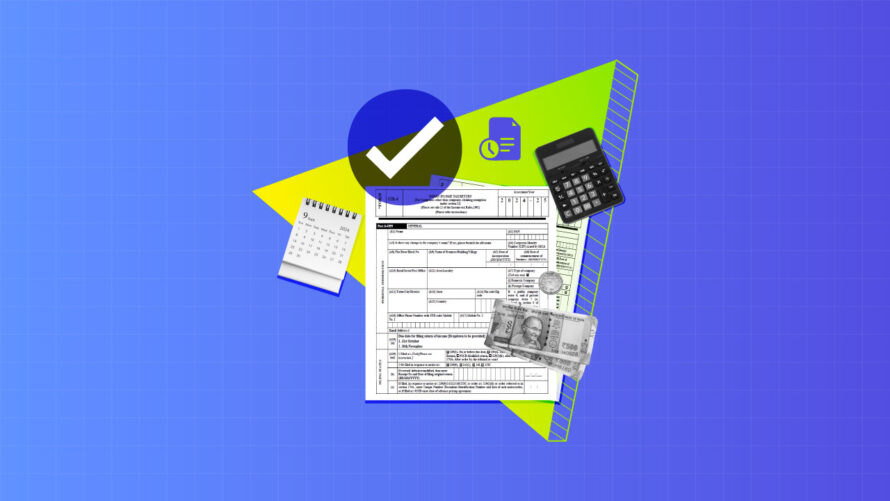
Taxes are to be paid and returns duly filed. Filing income tax returns is mandatory if you have a source of income. If your only source of income is salary, things are a lot more easier. But if you also have income from sources other than salary, you need to use the ITR-2 form to file your tax return. However, one must remember that the capital gain ITR form or ITR form 2 is only applicable for income from capital gains, salaries, and several other incomes like dividends, income tax deferred on ESOPs, and winning lottery.
If you are concerned about how to file an ITR form for capital gain, keep reading. This blog post will discuss everything you need to know about filing ITR-2 for income from capital gains.
Eligibility criteria to file ITR-2 form
Before you learn about the process of filing capital gain ITR form or ITR-2 form, let’s begin from the basics for a clearer understanding. We will discuss the eligibility criteria to file ITR-2 form for capital gains:
- Salaried or pensioned individuals with earnings of above Rs 50 lakh per annum.
- Any member of HUF or Hindu Undivided family or Indian citizen
- Individuals earning capital gains from mutual funds, the sale of shares, immovable properties, digital or virtual assets etc.
- If the individual has rental earnings from multiple house properties
- If the individual has foreign assets to generate their capital gains
- If the individual holds an equity share of an unlisted company
- If the individual is a director of a company or organization
- If the individual has brought forward a loss or loss to be carried under any income head
- Individuals with other earning sources such as lottery, horse racing, etc.
NB: Please note that if your capital earning source involves a profession, business, partnership firm, and so on, you are not eligible for the ITR-2 form.
Documents required to file ITR-2 form
We have discussed the eligibility criteria for filing the ITR-2 form for capital gains. If you meet the above-mentioned eligibility criteria, you can file your taxes through the ITR -2 form. Now, we will learn about the documents you will need to keep in handy to file ITR-2 form:
- PAN or Permanent Account Number Card
- Aadhaar Card
- Form 26AS or TDS certificate
- Form 16 (if you are a salaried individual)
- Chalan of previously paid taxes
- TIS or AIS certificate from the official income tax portal
- Details of your bank account
- Notice-related details (in case you are filing your tax in response to any kind of notice)
- Original details of tax returns (in case you are filing a revised return)
Documents required for filing capital gain ITR form
Here are some more details about the documents you will require to have for filing the capital gain ITR form:
1. For equity shares, mutual funds, and virtual/digital assets:
- Individuals can check their stock brokers for Tax P&L or capital gain statements for the sale of equity shares.
- Individuals can generate consolidated capital gain statements from CAMS for the sale of mutual fund units.
- For the virtual or digital asset transactions, individuals can generate profit-loss reports or transaction reports from the respective exchanges.
2. For the sale of immovable properties:
- Purchase and sale deeds, details of improvement costs, and transfer expenses that include sale value, cost of improvement, and purchase value.
- Details of the buyer such as PAN Card, Aadhaar Card, etc.
- Full address of the property.
- Other necessary supporting documents that you may require if you are claiming an exemption 54EC or u/s 54.
3. For any other type of capital gain-
- You should have a document that details purchase cost details as well as any sale considerations as required.
Steps to file income tax returns for capital gains on the e-filing portal
Taxpayers must file ITR for capital gain and salary to comply with the Indian government’s tax laws. One can also get various benefits by filing an income tax return. Here are the steps you need to follow to file ITR for capital gains.
Step 1:
Visit the official website of the income tax department and log in using the required credentials. Also, keep all the necessary documents handy, so that you do not face any hassle while filing your capital gain ITR form.
Step 2:
You need to click on the ‘e-file’ tab and select ‘Income Tax Returns’ from the list. After that, you should click on ‘File Income Tax Returns’ to begin the process.
Step 3:
After that, one must select the assessment year, for example, 2023-2024. After this, select ‘Online’ as the mode for filing ITR.
Step 4:
Next, choose the status and the type of ITR file. In this case, choose ITR-2 file. After choosing your file type, select the reason for filing ITR or ‘Taxable income is more than basic exemption limit’ and then click on ‘Continue’.
Step 5:
On the next page, you will see 5 types of schedules. Here, you must select the ‘General’ tab and then click on ‘Income Schedule’.
Step 6:
There are primarily two types of capital gains—long-term and short-term capital gains. Select ‘Schedule Capital Gains’ and choose the appropriate type of capital asset from the given list.
Step 7:
You have to review Part B TTI once you have confirmed the required schedule depending on LTCG and STCG.
Step 8: After completing your Part B TTI review, you will get a ‘pay now’ option (if there is any additional tax liability you have) to make your tax payments.
Step 9:
Once you are done with Part B TTI review and payment stage, you will proceed by clicking on the ‘preview returns’ option.
Step 10:
Here, you will get the chance to preview your return details. Once you have reviewed the details carefully, you can proceed by clicking on the ‘validation’ option.
Step 11:
Once it is validated and filed, you have to verify your filed ITR within 30 days after filing. You can verify your filed ITR form in two ways. The first is to mail a printout of your ITR-V (the acknowledgement form) to the IT department. The other way to verify the filed ITR is relatively simpler as all you need to do is verify it online via net banking using Aadhaar OTP.
Latest changes in ITR-2 filing: FY 2024-25
- According to the latest changes in ITR filing, all listed securities have a holding period of 12 months. Exceeding the 12-month period will considered long-term holdings. For other asset holdings, the time frame is 24 months.
- The classification asset will be on two bases, long-term and short-term. The latest changes have removed the 36 months of holding division.
- The exemption limit on long-term capital gains from equity-oriented units, units of business trust and transfer of equity shares has been raised to Rs. 1.25 lakh from Rs. 1 lakh per year at a tax rate of 12.5% from 10%.
- The short-term capital gains from the listed equity shares, unit of business trust or unit of equity-oriented funds have also been raised from 15% to 20%. On the other hand, other financial or non-financial assets that are held for the short term will continue to have slab rate taxes.
- The tax rate of other assets has changed from 20% to 12.5%, effective 23 July, 2024. The indexation benefits on long-term assets have also been eliminated. But taxpayers are allowed to compute taxes on real estate properties brought before 23 July 2024 either at 20% with indexation or at 12.5% without indexation.
Conclusion
Filing ITR-2, also known as capital gain ITR from salary and other capital gains, is mandatory for the category of individuals who have income besides salary. A taxpayer should know essential details for filing an ITR-2 form such as how to file a capital gain ITR form, what documents you will need to have, and what makes you eligible for filing an ITR-2 form. Hope now you have a clear idea on how to file ITR form 2 for income from capital gains.







